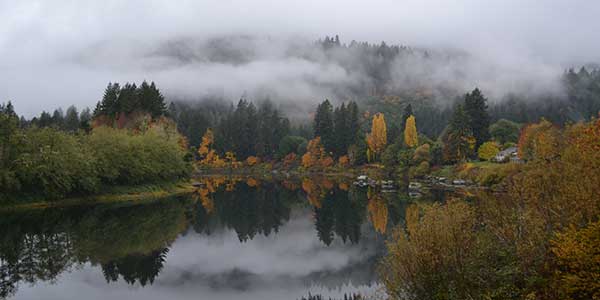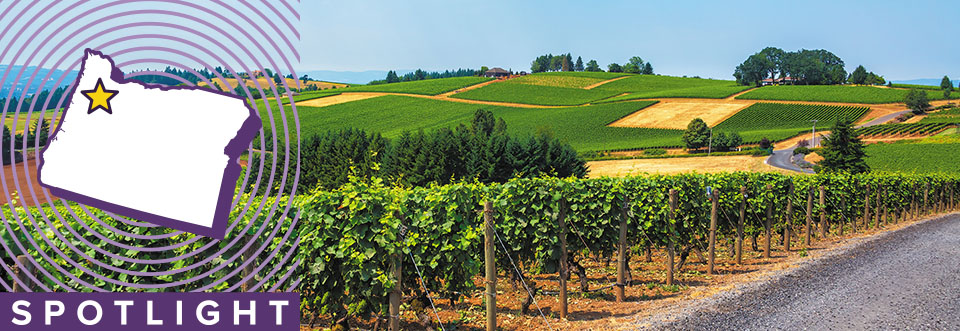Wine Regions
Take a sip (or two) of Oregon’s wide spectrum of varietals
Oregon is a great place for wine enthusiasts, with numerous American Viticultural Areas (AVAs) found throughout the state. Producers of fine vintages are concentrated in three major regions: Southern Oregon, the Columbia Gorge and the Willamette Valley. And while wine is a big draw for many visitors, all three regions have plenty more to offer, from fine and performing arts to gorgeous forest trails.
The AVA’s throughout Oregon vary widely in products, ranging from delightful Chardonnays to compelling Pinot Noirs. All wineries share the friendliness that is common in the Pacific Northwest. You can find wine touring maps for the various regions online, enabling you to plan your trips. As always, use a designated driver if you plant to do some serious wine tasting.
Southern Oregon
Southern Oregon is a vibrant wine-producing area with diverse microclimates: some areas are excellent for growing Burgundian varieties, while other places have a climate like Bordeaux in France. This part of the state has two major viticultural regions: Umpqua Valley and the Rogue Valley. Like most parts of the state, Pinots reign supreme in Umpqua, whereas the Rogue Valley is also celebrated for its Burgundies, Cabs and Merlots.
Awesome Umpqua: Named by the Chinook people, Umpqua translates into English as “thundering water.” It’s an apt description: The river is a haven for whitewater enthusiasts, and outfitters are available to give novices and experienced hands alike a chance to ride the rapids.

Visitor7
The North Umpqua River also is known for its fishing, and seasonal runs of salmon and steelhead draw anglers from around the country. Those who aren’t anglers can watch the fish in their native waters as they swim by a viewing window at Winchester Dam. Whitewater rafting is also popular on the river, and rafters flock to test the rapids.
The Umpqua National Forest comprises nearly a million acres in southwest Oregon. The area is known for innumerable recreation opportunities and beautiful waterfalls. The North Umpqua Wild and Scenic River Corridor is a national scenic byway featuring fly-fishing, whitewater rafting and other recreation options. The byway leads to Diamond Lake and extinct volcanoes Mount Thielsen and Mount Bailey. A welcome detour is Crater Lake National Park to the east.
In the north of the valley, Elkton is home to a concentration of four wineries, producing everything from Riesling to Pinot Noir to Baco Noir. It’s estimated that the area has the highest number of wineries per capita, and visitors are welcome to tour the region to explore the local vintages. It also attracts sport fishing enthusiasts to the banks of the river.
Following the waterway about 48 miles south, you’ll encounter the “Colliding Rivers,” which described the contact point between the north-flowing Little River and a south-flowing segment of the North Umpqua River. The two rivers merge at a nearly head-on angle, resulting in a turbulent confluence of two strong currents. The Colliding Rivers Information Center, housed in the Glide Ranger Station, offers insights into the geological history of the region and the peoples who have made the area their home.
When you’re not marveling at crashing currents, travel 11 miles west to Roseburg, home to 25 wineries. Vintners in the area are known for award-winning Baco Noir, Syrah, Tempranillo, Grüner Veltliner and Riesling. Pick up a wine map at the chamber of commerce and set out on an unforgettable winery tour throughout the region.
Shopping opportunities in the area are as diverse as the wine varieties produced. Quaint shops, antique stores and, of course, all things wine are showcased. Many of the wineries have their own gift shops.
Rogue Wines: The Rogue Valley AVA’s diverse climate and soil conditions has resulted in one of the most eclectic assortments of wine in the state. For wine tourists, this means sampling a delightfully wide spectrum of vintages. Many folks visit the area for the charming communities of Ashland, Medford and Grants Pass, but the wineries here attract much of the attention.
Located along the middle Rogue River across Jackson and Josephine counties, the Rogue Valley AVA is the southernmost grape-growing region in Oregon as well as the largest within the Southern Oregon AVA. Traversed by Interstate 5, it’s made up of three adjacent river valleys — Bear Creek, Applegate and Illinois valleys — that extend from the foothills of the Siskiyou Mountains along the California border north to the Rogue River. Measuring 70-miles wide by 60-miles long, the western reaches of the AVA enjoy the cool ocean climate (cold-weather vintages), while the eastern wineries tend to bask in warmer, dryer climes (dry vintages).
When not tasting wines, enjoy the recreation on the Rogue River, where fishing and white water thrills reign supreme.
The Columbia Gorge
This lush, fertile region marks part of the border between Oregon and its northern neighbor, Washington. Here you’ll find numerous wineries producing everything from cabernet to Riesling, plus tons of opportunities for outdoor adventure.
If you’re coming up from Portland, stop off at the Vista House on Crown Point, a 1918 historic house built in a vaguely Art Nouveau style with a lovely domed interior and great views out onto the Columbia River from its parking lot. It’s one of the first stops most travelers make in the Columbia Gorge on their way out to one of the state’s most popular attractions: the towering Multnomah Falls. With a drop of 620 feet, it’s the highest waterfall in the state and attracts busloads of visitors throughout the year who come to take photos or hike the short trails surrounding the attraction. Other popular waterfalls in the area include Horsetail Falls (yes, it resembles a horsetail).
Continuing East along Interstate 84, you’ll eventually hit Hood River, a charming town full of quaint boutiques, pubs and restaurants, plus ample wineries offering some of the finest wines produced in the verdant region. Naked Winery, Cathedral Ridge and Marchesi Vineyards are some of ther best known. Hood River also touts itself as the world capital of windsurfing, with plenty of launch points within city limits.
One of the best ways to get a good feel for the area is by driving the Hood River County Fruit Loop, a 35-mile-long scenic loop that spans across the Hood River Valley, passing by U-pick fruit and vegetable farms, farm stands, vineyards and wineries. There are also a few surprising stops along the way, including alpaca and lavender farms.

Luke
Willamette Valley
Immediately south of Portland along Interstate 5, the Willamette Valley is easily the most celebrated wine region in Oregon (and it’s usually what people mean when they speak of “Oregon wine country”).
Here, you’ll find plenty of charming little towns full of tasting rooms, restaurants (many of which offer Pacific Northwest fine-dining), boutiques and ice cream parlors. The first of these is Newberg, a charming old pioneer city surrounded by rolling vineyards. A short drive south, Dundee is like a scaled-down version, with an adorable main street chock-full of tasting rooms. It’s part of the Dundee Hills AVA, which is filled with wineries spread out on scenic slopes. A short drive from here, Red Ridge is a large countryside complex that encompasses both the Oregon Olive Mill (which makes some fine olive oils) and Durant Vineyards along with their own small commercial nursery. Stop by for site tours or olive oil tastings.
The next city in the valley, McMinnville is among the most adorable cities in the area, with an old-style movie theater, a cute ice cream shop, and lots of great restaurants, from fine-dining at Thistle to casual American fare at the Oregon Hotel (run by Oregon’s popular family-run pub/hotel chain, McMenamins). Just outside the city is the Evergreen Aviation and Air Museum, home of the famous Spruce Goose, a flying boat that was built by Howard Hughes for use in World War II. The museum also is home to the popular Wings and Waves waterpark, featuring a huge waterslide that emerges from a 747-jumbo jet. To the south lies Salem, the state capital and a charming host to the Oregon Grape Stomp, Oregon State Fair, Oktoberfest and other fun-filled events. Beer lovers will also discover lots of microbreweries in the area.
If you keep heading south through the valley, you’ll eventually find yourself in Eugene, the second-largest city and home to the University of Oregon. This compact town offers plenty of interesting things to see and do, including the University of Oregon’s Museum of Natural and Cultural History, which focuses on the anthropological and natural history of the region. If you come during the weekend, visit the Eugene Saturday Market, which offers local crafts and food carts, plus plenty of live entertainment.
Southeast of town is the 209-acre Mt. Pisgah Arboretum is a living tree museum featuring riverside paths through evergreen forests and wildflower meadows on the slopes of Mt. Pisgah. Each fall, the Arboretum hosts the Mushroom Festival with over 400 varieties of wild fungus starring in the celebration.
Blue River Roaming
About 40 miles to the east of Eugene is Blue River, one of the most charming towns in the Willamette Valley. This vibrant community sits on the northern bank of the McKenzie River. Walk the Belknap Covered Bridge, take a dip in one of the nearby reservoirs or stroll its quaint streets.
Blue River is named for the striking color of the rocky river bed, but the description doesn’t do justice to the kaleidoscope of recreation available in the area. Drop a line in one of the fishing hot spots, test your thrill-seeking limits with a whitewater rafting trip or go hiking on the McKenzie River trail. The Pacific Tree Climbing Institute will awaken your inner child with the chance to scale the towering trunks of the region’s Douglas firs, hemlocks, cedars and more.
While in Blue River, check out the nearby farmers markets, where blueberries, hazelnuts and more are served up fresh for travelers looking for a snack or a complement to dinner. The region is also home to some of the world’s best pinot noir; no trip would be complete without a taste at a local winery.
For More Information
Oregon Wine Board
503-228-8336
www.oregonwine.org
Oregon Tourism Commission
800-547-7842
www.traveloregon.com







